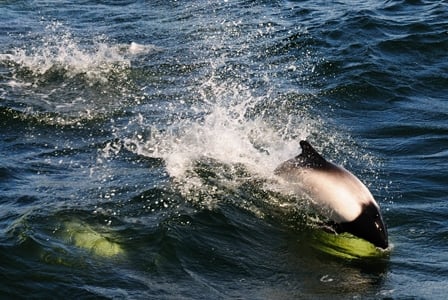
This week, we discuss two very important questions: who was Commerson? Why were dolphins named after him?
If you sat down in a school library with a marine wildlife book when you were a kid and wondered about those little dolphins that look like backwards orcas, then you’ve marvelled at Commerson’s dolphins.
Relive that childhood sense of wonder on this Wildlife Wednesday as we splash head-first into a wealth of knowledge about these curious marine mammals.
Habitat
Commerson’s dolphins can be found along the South American coast. More specifically, they can generally be found splashing and leaping along the coastlines, bays, harbours, and river mouths that dot the coasts of Argentina, Chile, the Falkland Islands, and the French Southern Territories.
Trivia
- Let’s get the obvious questions out of the way first: who was Commerson? Why were dolphins named after him?
- Philibert Commerson was a French botanist, explorer, and naturalist who studied South America, the South Pacific Islands, and a number of different places in the southern hemisphere.
- He first noted these dolphins in 1767 on his way to South America.
- They may carry the name of their discoverer, but these dolphins also go by a number of different—and some very apt—names, including bridled dolphins, piebald dolphins, ground porpoises, and springers.
- No matter the name, though, these sleek swimmers didn’t get to be black and white because of a run-in with an orca—their distinctive colouration works as a type of camouflage known as “disruptive colouration,” which conceals the dolphin’s outline and confuses predators.
- Since they’re one of the world’s smallest dolphin species but have a very fast metabolism, Commerson’s dolphins can’t be choosy when it comes to catching a meal. They’re well known for their opportunistic feeding behaviours, feeding on whichever squid, fish, and shrimp species they find on a given day.
Why are they threatened?
Researchers aren’t actually sure if these aquatic acrobats are threatened—there just isn’t enough research right now to give us a clear idea if their numbers are decreasing, increasing, or stable.
In the past, Commerson’s dolphins were hunted for their meat and oil, and they were also once caught and used as crab bait in both the Argentine and Chilean fisheries industries. However, these practices are now illegal.
Fisheries, however, still do play a damaging role. They use gillnets and trawls to harvest hake, shrimp, and other common marine exports, and the dolphins have been known to get caught in the nets at several points along the South American coast.
If you enjoy a freshly gilled seafood dinner from time to time, do the dolphins a favour—make sure that the delicacy that will soon be adorning your barbecue has been sustainably caught. Asking your local fishmonger for suggestions, doing your research, and keeping an eye out for an Ocean Wise logo are all good ways to make sure these little marine mammals keep smiling.















